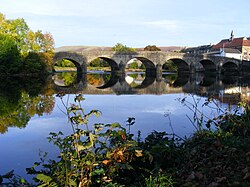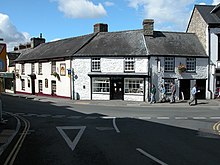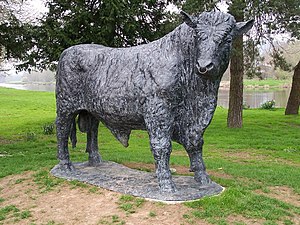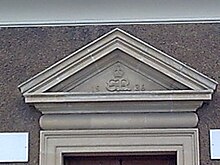Builth Wells: Difference between revisions
mNo edit summary |
|||
| Line 55: | Line 55: | ||
One of the main Wales north-south trunk roads, the A483, passes through the town, using the former railway route. | One of the main Wales north-south trunk roads, the A483, passes through the town, using the former railway route. | ||
[[File:Builth_PO_main.jpg|right|thumb|220px|Photo showing cypher of King Edward VIII above Post Office]] | |||
==References== | ==References== | ||
Revision as of 18:15, 6 September 2014
| Builth Wells Welsh: Llanfair ym Muallt | |
| Brecknockshire | |
|---|---|
 Bridge over the Wye at Builth Wells | |
| Location | |
| Grid reference: | SO035505 |
| Location: | 52°8’24"N, 3°24’36"W |
| Data | |
| Population: | 2,352 (2001) |
| Post town: | Builth Wells |
| Postcode: | LD2 |
| Dialling code: | 01982 |
| Local Government | |
| Council: | Powys |
| Parliamentary constituency: |
Brecon & Radnorshire |
Builth Wells is a town in Brecknockshire, lying at the meeting of the River Wye and the River Irfon, in the upper reaches of the Wye Valley.
History and geography
Builth first emerged in post-Roman times, probably on the other side of the Irfon river from its present site at Dol Eglwys (Church Mound) where a ruined early medieval church is thought to be. A legend has it that Vortigern, the British ruler said to have invited the Saxons to Britain, owned land in nearby Builth Road on the Radnorshire side of the river Wye; the site previously having been known as Cwrt Llechrhyd.
Early Post-Roman Builth was an independent kingdom. The most famous ruler was Elystan Glodrydd from whom many local gentry claimed descent. As an important component of Rhwng Gwy a Hafren, a political entity referred to in the poems of Taliesin, Builth was regularly at war with the Kingdom of Powys. Ecclesiastically, the Deanery of Builth was part of the Diocese of St David's until the creation of the Diocese of Swansea and Brecon, indicating that Kingdom of Powys, which gave rise to the neighbouring Diocese of St Asaph, did not stretch this far south.
In those days, the modern site of Builth Wells was not the most important town but Llanafan Fawr, which was probably Glodrydd's capital. Until the foundation of the Norman town Llanfair ym Muallt, the main settlement was Llanafan. Stories about Philip de Braose centre on Llanafan not modern Builth.
The site of the town controls an important ford across the river Wye and the crossing point of the main north-south route in Wales and an important South West-East route. It was militarily and economically significant for centuries. The Welsh name for the town "Llanfair ym Muallt" refers to the foundation of a Norman church dedicated to St Mary. The churchyard is however, a truncated oval which is strongly suggestive of an original Celtic foundation. The town was laid out as two streets connecting a castle and a church. The town was protected by a hedge rather than a wall. This type of town is sometimes called a Bastide, a kind of medieval supermarket. In exchange for rights to live and trade in the market of the new town skilled townspeople paid the lord various dues. In many parts of Wales, the skilled workers were of Flemish or English origin. However, Builth may have had important significance in Welsh language culture. The Mabinogion was long thought to have been recorded in its final form by medieval monks. Recent historical opinion has shifted to a view that it was written down by a lawyer in Builth.

Despite repeated destructive fires, at one time involving a charitable collection in London, Builth Wells grew as a traditional Welsh market town. It received major boosts from the development of toll roads; it was at the centre of a network and the arrival of the railway at Llanelwedd. The railway allowed it to develop as a spa, and is well known nationally as the location of the Royal Welsh Showground, home to the Royal Welsh Show, though the showground itself is actually over the River Wye in Llanelwedd, Radnorshire.
Builth Castle
Builth Castle was built under King Edward I, construction taking nearly five years in the 1270s. It replaced an earlier castle built by the Marcher Baron Philip De Braose who claimed the area as a Marcher lordship. There may also have been an earlier castle or Roman fort at Caerberis (the fort of Peris) on the north side of the river Irfon by the original settlement.
Llywelyn ap Gruffudd, prince of Gwynedd, known in North Wales as Llywelyn Ein Llyw Olaf accompanied only by a squire was refused entry to Builth Castle following an ambush by an Anglo-Norman war party from Hay. In Erwood, a village close to Builth Wells, he escaped from ambush by asking a smith (Madoc Coch) to turn around his horses hooves to leave a false trail. He hid the night in a "cave" at Aberedw rocks. He was killed attempting to rejoin his men at Cilmeri. In one version of the story he holds a narrow bridge across the Irfon against the war party from Hay while his squire rides for help. There is a monument to Llywelyn at nearby Cilmeri, where his men having lost their leader were routed without much effort by the Normans. In another version, perhaps more likely, he was killed by accidental chance (medieval nobles usually captured each other for ransom) and his body not recognised until later. This is sometimes referred to as the battle of Irfon Bridge. He had come south to rally the men of the Lordship of Builth in December 1282 as part of a dispute about the ownership of the commote of Arwystli.
Owain Glyndŵr's forces attacked Builth Castle[1] during his rebellion, when it was in the charge of John Oldcastle. It was repaired in 1409, at a cost of £400.
Edward VIII postbox
Builth Wells has the distinction of having one of the very few post boxes in the United Kingdom bearing the cypher of King Edward VIII, the uncrowned king whose abdication in 1936 caused a constitutional crisis.
Livestock breeds
The name Builth is derived from the Welsh Bu-Allt which loosely translated means cattle range. The White Bull of Builth may be a reference to a herd of White Park Cattle that lived in the area from Post-Roman times, of which two herds survived in Wales to modern times. The laws of the time suggest that the medieval and later economy of the Welsh Borders was strongly dependent on cattle.

The Hereford cattle breed, named after Hereford market where it was most prominently sold, was the main breed of the Welsh borders. Builth was the market for a variant of the Hereford called the Builth Smokey Face. This was the traditional animal of the area but the breed has not existed for many, many decades. The Welsh Black cattle have very little to do with the history of Builth, except that Cardiganshire cattle-drovers drove herds of cattle through Builth to markets in England. Beef cattle have largely vanished from the area.
The Beulah Speckled Face is a local breed of sheep. Nearby Mynydd Epynt was famous for its horses until it was seized for military purposes.
The market has vanished and economically sheep are now vastly more important than cattle with consequences for the traditional woodlands of the area, the salmon runs and other important ecological features.
Communications
The town is served by Builth Road railway station on the Heart of Wales Line, which is located just over a mile to the north, having lost its more central railway station on the Mid Wales Railway in the 1960s under the "Beeching Axe". A dedicated cycle route linking the town with Swansea (NCR 43) has been proposed and a 13-mile section of the route from Swansea has already been developed.
One of the main Wales north-south trunk roads, the A483, passes through the town, using the former railway route.

References
- ↑ Builth Castle castlewales.com